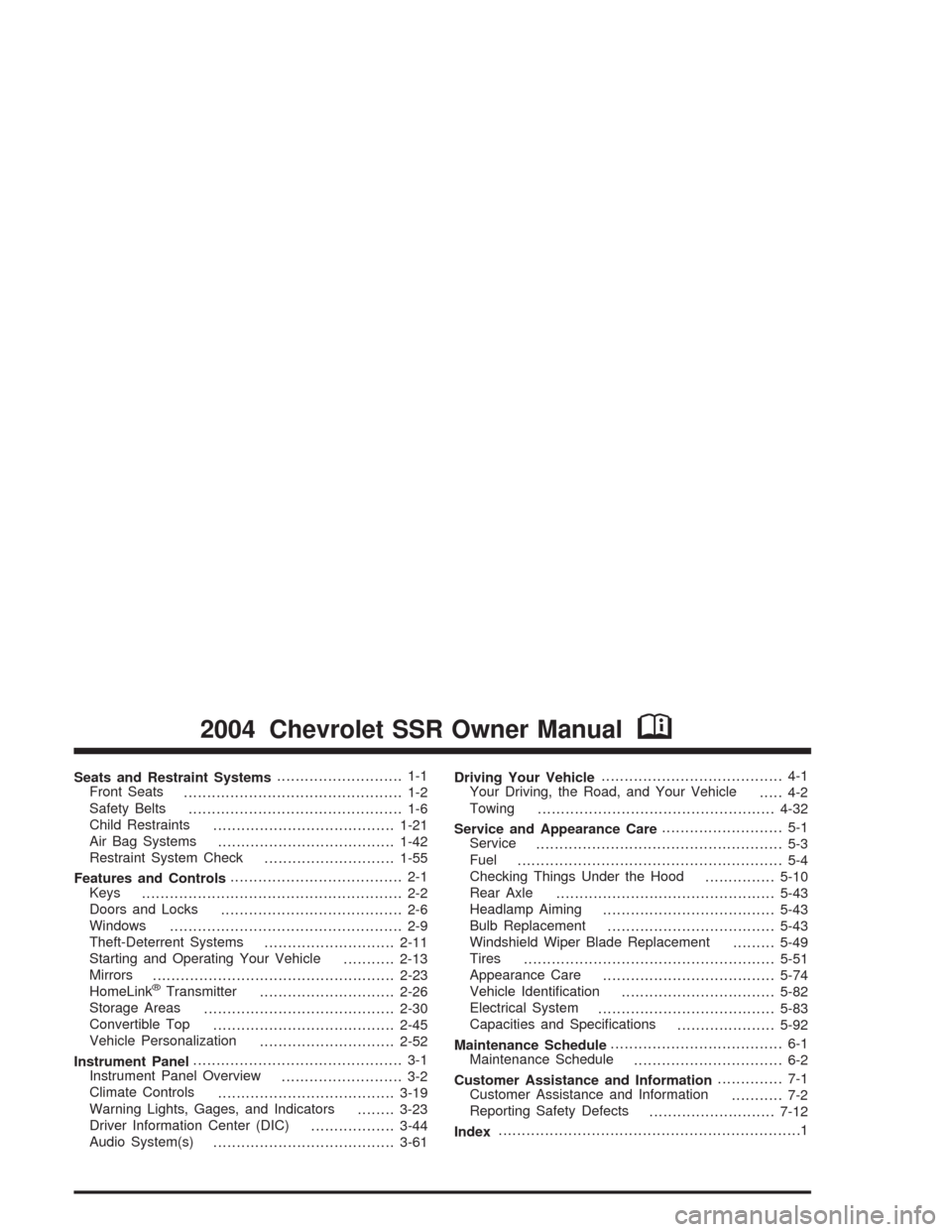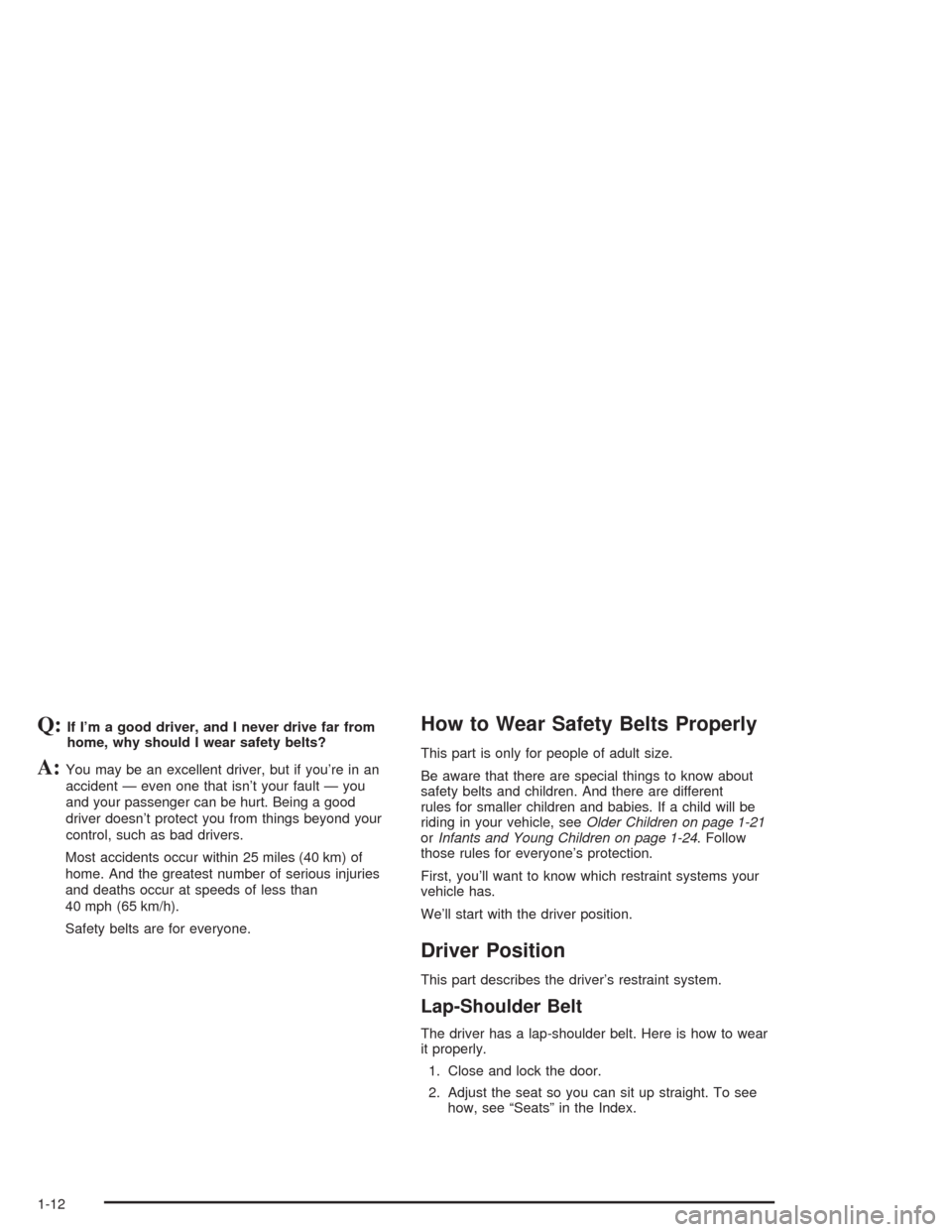2004 CHEVROLET SSR child lock
[x] Cancel search: child lockPage 1 of 398

Seats and Restraint Systems........................... 1-1
Front Seats
............................................... 1-2
Safety Belts
.............................................. 1-6
Child Restraints
.......................................1-21
Air Bag Systems
......................................1-42
Restraint System Check
............................1-55
Features and Controls..................................... 2-1
Keys
........................................................ 2-2
Doors and Locks
....................................... 2-6
Windows
.................................................. 2-9
Theft-Deterrent Systems
............................2-11
Starting and Operating Your Vehicle
...........2-13
Mirrors
....................................................2-23
HomeLink
®Transmitter
.............................2-26
Storage Areas
.........................................2-30
Convertible Top
.......................................2-45
Vehicle Personalization
.............................2-52
Instrument Panel............................................. 3-1
Instrument Panel Overview
.......................... 3-2
Climate Controls
......................................3-19
Warning Lights, Gages, and Indicators
........3-23
Driver Information Center (DIC)
..................3-44
Audio System(s)
.......................................3-61Driving Your Vehicle....................................... 4-1
Your Driving, the Road, and Your Vehicle
..... 4-2
Towing
...................................................4-32
Service and Appearance Care.......................... 5-1
Service
..................................................... 5-3
Fuel
......................................................... 5-4
Checking Things Under the Hood
...............5-10
Rear Axle
...............................................5-43
Headlamp Aiming
.....................................5-43
Bulb Replacement
....................................5-43
Windshield Wiper Blade Replacement
.........5-49
Tires
......................................................5-51
Appearance Care
.....................................5-74
Vehicle Identi�cation
.................................5-82
Electrical System
......................................5-83
Capacities and Speci�cations
.....................5-92
Maintenance Schedule..................................... 6-1
Maintenance Schedule
................................ 6-2
Customer Assistance and Information.............. 7-1
Customer Assistance and Information
........... 7-2
Reporting Safety Defects
...........................7-12
Index.................................................................1
2004 Chevrolet SSR Owner ManualM
Page 18 of 398

Q:If I’m a good driver, and I never drive far from
home, why should I wear safety belts?
A:You may be an excellent driver, but if you’re in an
accident — even one that isn’t your fault — you
and your passenger can be hurt. Being a good
driver doesn’t protect you from things beyond your
control, such as bad drivers.
Most accidents occur within 25 miles (40 km) of
home. And the greatest number of serious injuries
and deaths occur at speeds of less than
40 mph (65 km/h).
Safety belts are for everyone.
How to Wear Safety Belts Properly
This part is only for people of adult size.
Be aware that there are special things to know about
safety belts and children. And there are different
rules for smaller children and babies. If a child will be
riding in your vehicle, seeOlder Children on page 1-21
orInfants and Young Children on page 1-24. Follow
those rules for everyone’s protection.
First, you’ll want to know which restraint systems your
vehicle has.
We’ll start with the driver position.
Driver Position
This part describes the driver’s restraint system.
Lap-Shoulder Belt
The driver has a lap-shoulder belt. Here is how to wear
it properly.
1. Close and lock the door.
2. Adjust the seat so you can sit up straight. To see
how, see “Seats” in the Index.
1-12
Page 26 of 398

The best way to protect the fetus is to protect the
mother. When a safety belt is worn properly, it’s more
likely that the fetus won’t be hurt in a crash. For
pregnant women, as for anyone, the key to making
safety belts effective is wearing them properly.
Passenger Position
To learn how to wear the passenger’s safety belt
properly, seeDriver Position on page 1-12.
The passenger’s safety belt works the same way as the
driver’s safety belt — except for one thing. If you
ever pull the shoulder portion of the belt out all the way,
you will engage the child restraint locking feature. If
this happens, just let the belt go back all the way and
start again.
Safety Belt Extender
If the vehicle’s safety belt will fasten around you, you
should use it.
But if a safety belt isn’t long enough to fasten, your
dealer will order you an extender. It’s free. When you go
in to order it, take the heaviest coat you will wear, so
the extender will be long enough for you. The extender
will be just for you, and just for the seat in your
vehicle that you choose. Don’t let someone else use it,
and use it only for the seat it is made to �t. To wear
it, just attach it to the regular safety belt.
1-20
Page 68 of 398

Notice:When replacing the battery, use care not to
touch any of the circuitry. Static from your body
transferred to these surfaces may damage the
transmitter.
To replace the battery in the remote keyless entry
transmitter do the following:
1. Insert a thin coin in the slot between the covers of
the transmitter housing. Gently pry the transmitter
apart.
2. Remove and replace the battery with a three-volt
CR2032 or equivalent battery.
3. Align the covers and snap them together.
4. Check the operation of the transmitter.Doors and Locks
Door Locks
{CAUTION:
Unlocked doors can be dangerous.
Passengers — especially children — can
easily open the doors and fall out of a
moving vehicle. When a door is locked, the
handle will not open it. You increase the
chance of being thrown out of the vehicle
in a crash if the doors are not locked. So,
wear safety belts properly and lock the
doors whenever you drive.
Young children who get into unlocked
vehicles may be unable to get out. A child
can be overcome by extreme heat and can
suffer permanent injuries or even death
from heat stroke. Always lock your vehicle
whenever you leave it.
Outsiders can easily enter through an
unlocked door when you slow down or
stop your vehicle. Locking your doors can
help prevent this from happening.
2-6
Page 216 of 398

Steering in Emergencies
There are times when steering can be more effective
than braking. For example, you come over a hill and �nd
a truck stopped in your lane, or a car suddenly pulls
out from nowhere, or a child darts out from between
parked cars and stops right in front of you. You
can avoid these problems by braking — if you can stop
in time. But sometimes you can not; there is not
room. That is the time for evasive action — steering
around the problem.
Your vehicle can perform very well in emergencies like
these. First apply your brakes.
SeeBraking on page 4-6. It is better to remove as much
speed as you can from a possible collision. Then
steer around the problem, to the left or right depending
on the space available.An emergency like this requires close attention and a
quick decision. If you are holding the steering wheel at
the recommended 9 and 3 o’clock positions, you
can turn it a full 180 degrees very quickly without
removing either hand. But you have to act fast, steer
quickly, and just as quickly straighten the wheel
once you have avoided the object.
The fact that such emergency situations are always
possible is a good reason to practice defensive driving
at all times and wear safety belts properly.
4-12
Page 390 of 398

J
Jump Starting.................................................5-37
K
Keyless Entry System....................................... 2-3
Keys............................................................... 2-2
L
Lamps
Exterior......................................................3-12
Interior.......................................................3-15
Lamps On Reminder.......................................3-13
Lap-Shoulder Belt...........................................1-12
LATCH System
Child Restraints...........................................1-32
Securing a Child Restraint Designed for the
LATCH System........................................1-34
Latches, Seatback............................................ 1-6
Leaving Your Vehicle......................................... 2-8
Leaving Your Vehicle With the Engine Running . . . 2-20Light
Air Bag Off .................................................3-28
Air Bag Readiness.......................................3-26
Anti-Lock Brake System Warning...................3-31
Brake System Warning.................................3-30
Change Engine Oil......................................3-37
Charging System.........................................3-29
Check Gages Warning.................................3-39
Cruise Control.............................................3-38
Highbeam On.............................................3-39
Malfunction Indicator....................................3-32
Reduced Engine Power................................3-38
Safety Belt Reminder...................................3-26
Security.....................................................3-37
TCS Warning Light......................................3-31
Traction Control System (TCS) Warning..........3-31
Lighted Visor Vanity Mirrors..............................2-11
Loading Your Vehicle.......................................4-32
Locks
Door........................................................... 2-6
Leaving Your Vehicle..................................... 2-8
Power Door.................................................. 2-7
Programmable Automatic Door Locks............... 2-8
Loss of Control...............................................4-15
8
Page 392 of 398

Oil
Change Engine Oil Light...............................3-37
Engine.......................................................5-13
Pressure Gage............................................3-36
Oil Pressure Low Stop Engine..........................3-51
Older Children, Restraints................................1-21
Online Owner Center........................................ 7-4
Opening the Cargo Cover................................2-31
Other Warning Devices...................................... 3-4
Outlet Adjustment............................................3-22
Outside
Automatic Dimming Heated Mirror..................2-25
Convex Mirror.............................................2-25
Power Heated Mirrors..................................2-24
Overseas – Customer Assistance........................ 7-5
Owner Checks and Services.............................. 6-9
Owners, Canadian............................................... ii
Owner’s Information........................................7-13
P
Parade Dimming.............................................3-16
Park (P)
Shifting Into................................................2-19
Shifting Out of............................................2-20
Parking
Brake........................................................2-18
Over Things That Burn.................................2-21Parking on Hills..............................................4-50
Passenger Door Ajar.......................................3-52
Passenger Position, Safety Belts.......................1-20
Passenger’s Seat............................................. 1-3
Passing.................................................4-13, 4-49
Passlock
®......................................................2-13
Payload.........................................................4-38
Perimeter Lighting...........................................3-16
Personalization...............................................3-48
Plan Ahead When Possible................................ 7-8
Playing a CD.........................................3-68, 3-78
Playing a Speci�c Loaded CD..........................3-80
Playing the Radio...................................3-62, 3-71
Power
Accessory Outlets........................................3-17
Door Locks.................................................. 2-7
Electrical System.........................................5-83
Reduced Engine Light..................................3-38
Seat............................................................ 1-2
Steering Fluid.............................................5-31
Windows....................................................2-10
Power Steering...............................................4-11
Programmable Automatic Door Locks.................. 2-8
Programming the HomeLink
®Transmitter...........2-27
Programming the Power Windows.....................2-10
Put Vehicle in Park.........................................3-52
10